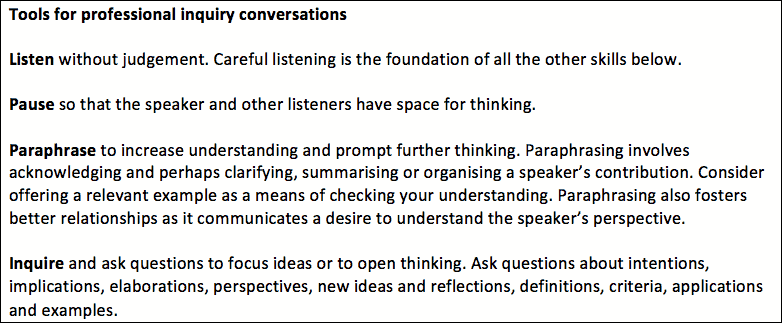Research shows that the best professional learning occurs through collaborative inquiries with other teachers in which you collectively question the effectiveness of teaching routines and explore new ideas on teaching and learning.
The benefits of collaborative inquiry:
- Provides a diversity of perspectives on students’ learning, generating a wider variety of insights, hypotheses, assumptions and reflections than an individual.
- Offers more robust thinking because of the combined intellects and debate.
- Enables the exchange of resources, knowledge and expertise so that joint solutions can be developed to shared problems.
- Breaks down barriers to learning and reflection caused by the isolation of individual teachers and supports mutual mentoring.
- Deepens professional relations among teachers. Promotes inclusiveness and collegiality as a source of emotional support to encourage perseverance and risk taking.
Steps for making collaborative inquiry work
- Carefully construct the group
- Seek out colleagues with similar levels of commitment and responsibility, and try to form a group with complementary knowledge.
- Allow time for the group to reach a high functioning level. New groups need to work through a relationship-forming stage. Strong relationships can enable group members to ask difficult questions or initiate ideas and solutions. The inquiry process and the group will develop in tandem.
- Plan for communication and collaboration
- Meet regularly (preferably every two weeks, or at least once a month), and focus meetings on learning and teaching activities.
- Agree agendas and initial questions for each meeting to focus discussion, save time, and maintain momentum and focus.
- Maintain focus by recording topics or questions that are not immediately relevant for later discussion.
- Balance participation by using structures or protocols for discussion (such as a round robin) or give each group member time to record their thoughts and ideas in writing before discussion.
- Build a range of flexible communication channels for the group outside of meetings.
- Maintain collaboration over a substantial period of time.
- Focus on relationships
- Develop relationships of respect and challenge that encourage risk taking and allow mistakes.
- Acknowledge difference and find constructive means to acknowledge and respond to your differences.
- Actively support and celebrate each other’s professional growth.
- Use a spiral of inquiry to select a topic
- Work through each stage of the spiral of inquiry together. Use the scanning and focusing and developing hunches stages to co-construct understanding of the evidence for your context.
- Negotiate a topic of inquiry that triggers the interest of the group, but perhaps also consider opportunities for individual choice within an agreed topic.
- Agree common values and goals – this takes time, spend at least a week and usually a month or more.
- Employ evidence
- Use good data and information as the basis for discussions, and ensure data is depersonalised.
- Sit around a copy of the data as a group — discussion is better facilitated when groups view the same data at the same time.
- Interrogate data and develop many interpretations and theories. Disclose your views and give your reasons for them. Provide examples.
- Be open-minded and tolerate ambiguity. Treat your views and those of others as hypotheses or hunches rather than as truths, and detect and challenge your own and others’ assumptions. Listen to others’ perspectives and be open to influence.
- Question, reason and probe ideas to push the thinking of the group further.
- Ensure shared commitment to agreed actions and goals
- Engage in group professional learning to identify potential innovations, and set goals collaboratively.
- Build commitment to group decisions for consistent implementation of agreed practices.
- Promote reflective dialogue
- Reflect on action and inquiries and share classroom experience.
- Structure interactions for better group learning.
- Coach each other in the implementation of strategies.
- Facilitate dialogue by providing feedback and conducting lesson observations, and analysing student work.

Potential problems
Keeping momentum going and maintaining commitment
- Agree the purpose of every meeting with planned agendas and focus questions. Ensure that you share small successes to keep the group energised.
A fear of conflict between teachers which restricts the free exchange of perceptions and opinions
- Try forming smaller task groups of 2–4 teachers, to increase feelings of safety.
